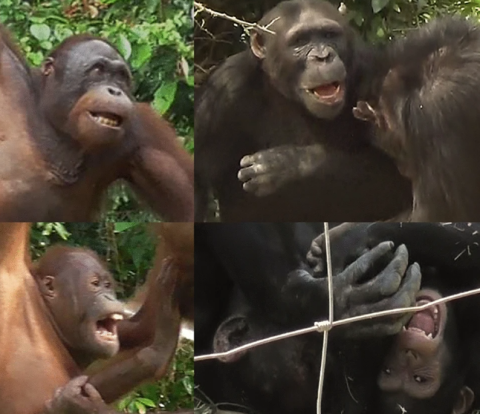

A new study has revealed humans are not the only species to change their laughing faces depending on who they are interacting with
18 November 2024
7 minutes
Animal behaviour experts have shed new light on the evolution of facial expressions, by analysing the laughing faces of orangutans and chimpanzees.
The study, led by the University of Portsmouth, has revealed humans are not the only great ape species to modify their expressions depending on who they are engaging with.
The science of smiles and laughing faces
Charles Darwin was one of the first to examine these facial expressions, in humans and nonhumans. He noted that the expression of emotions can be traced in animals too, and that some of them (like the “positive” ones) are extremely similar between humans and other primates.
A previous study led by researchers in Portsmouth reconstructed the evolution of smiles, and found that great apes produce laughter and that they use the same facial muscle activation as humans do.
Humans often vary the degree of mouth opening and teeth exposure when producing these facial expressions, which may depend on several factors, such as the characteristics of the social partner, their relationship with them, and the context of the interaction.
Different smiles serve different functions, which range from putting someone at ease and showing affection, to asserting authority and dominance.
Fabio Crepaldi from the University of Portsmouth’s School of Psychology, Sport and Health Sciences, said: “Smiles can tell us a lot about emotion and communication. They can be natural and genuine when we’re in a good mood, or fake and polite when we have to ‘grin and bear it’, in which case we usually do not open the mouth and contract the muscles around the eyes. These variations are present in humans from a very young age. Infants seem to produce broad smiles with teeth exposure more when their mother approaches and closed smiles with no teeth exposure more when a stranger does.
“While we have a good understanding of what these variations mean in humans, until now we knew little about their evolution. By looking at how other great-ape species use them, it helps us better understand the complexity of these pervasive human behaviours, as well as their role in human and nonhuman emotions and cognition.
New insights
By analysing over 600 facial expressions of 14 orangutans and 17 chimpanzees, the team discovered the animals would alter their laughing face (aka “play face”) depending on their playmate’s characteristics.
The results, published in Nature’s Scientific Reports, suggest that age difference and, to a lesser extent, playmate sex influences the type of laughing face.
The orangutans seemed to expose their upper teeth and pull their mouth corners towards weaker partners, such as the younger and female members of the group. The paper says these laughing faces are possibly being used to communicate reassurance.
The chimpanzees showed both upper and lower teeth exposure more often when interacting with stronger partners - such as older individuals - possibly to communicate submissiveness.
This suggests that humans' ability to modify laugh faces to different partners has most likely evolved from pre-existing traits from their most common ancestor with other great apes.
“That human expressions derived from nonhuman displays were already clear”, added Mr Crepaldi. "However, the more we look the more we realise how complex this nonverbal communication can be in other primates. In a handful of decades, we went from considering animals mere stimuli-responding machines, incapable of mental inner life, to accepting the idea that they experience some emotions and express them.
"Then, in the last 20 years or so, further studies have proved that nonhuman primates can indeed have more sophisticated emotional experiences and communicate nonverbally in a rather complex way, for example via facial expressions. But only by focusing our attention on the playmates, we have now seen how finely graded this communication could be.
Behavioural coding
The researchers were able to distinguish between the animals’ different facial expressions by identifying the specific facial muscles that were activated. They used a tool - developed in Portsmouth - known as OrangFACS and ChimpFACS.
The Facial Action Coding System, or FACS, was originally created in the seventies to break down human facial expressions into individual components of muscle movement, called Action Units (AU). Over the last two decades, behavioural experts from the University have adapted FACS to other species, and discovered muscle activations examined in both orangutans and chimpanzees are identical to those of humans.
Dr Marina Davila-Ross, Associate Professor in Comparative Psychology at the University of Portsmouth, said: “This new study supports our previously developed theoretical model on laughter and laughing faces, which states that they evolved before humans, and must have been used in complex ways in ancestral apes.
“The research examined these positive expressions in specific situations within the larger context of play; an approach that was used for the first time in order to assess the function of these expressions in great apes. Such a situation-focused approach allows us to more fully reconstruct the evolution of laughter and laughing faces across great apes and humans.”
The orangutans of this study lived at the Sepilok Orangutan Rehabilitation Centre (SORC) in Sabah, Malaysia. The chimpanzees lived in the Chimfunshi Wildlife Orphanage (CWO) in Zambia.
Photo credit:
Examples of laugh faces in orangutans (left) credit: Fabio Crepaldi
Examples of laugh faces in chimpanzees (right) credit: Helene Chotard
More like this...
New study shows how owners’ belief in horse emotion is linked to healthier animals
21 October 2024
3 minutes

Study finds socially tolerant monkeys have better impulse control
8 June 2023
5

Ecotourism is having a negative effect on primate behaviour
24 April 2022
3 min read

